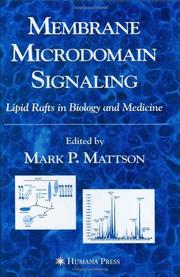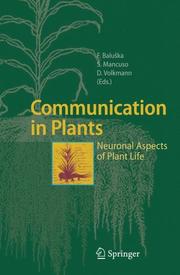| Listing 1 - 6 of 6 |
Sort by
|
Book
ISBN: 9781441994615 9781441994608 Year: 2011 Publisher: New York : Springer,
Abstract | Keywords | Export | Availability | Bookmark
 Loading...
Loading...Choose an application
- Reference Manager
- EndNote
- RefWorks (Direct export to RefWorks)
Signal transduction pathways are at the core of most biological processes and are critical regulators of heart physiology and pathophysiology. The heart is both a transmitter and dynamic receptor of a variety of intracellular and extracellular stimuli, playing a critical role of an integrator of diverse signaling mechanisms. Alterations in signaling pathways are contributing factors in the development and progression of a broad spectrum of diseases, ranging from dysrhythmias and atherosclerosis to hypertension and the metabolic syndrome. Targeting specific components of these signaling pathways has been shown to be effective in preclinical studies with significant therapeutic impact.
Human biochemistry --- Pathological biochemistry --- Pathology of the circulatory system --- biochemie --- cardiologie --- Heart --- Signal Transduction --- Heart Diseases --- Cellular signal transduction --- Coeur --- Transduction du signal cellulaire --- physiology. --- physiopathology. --- Physiology --- Pathophysiology --- Physiologie --- Physiopathologie --- EPUB-LIV-FT LIVMEDEC SPRINGER-B
Book
ISBN: 9783642235245 9783642235238 3642235239 3642235247 Year: 2012 Publisher: Heidelberg ; New York : Springer,
Abstract | Keywords | Export | Availability | Bookmark
 Loading...
Loading...Choose an application
- Reference Manager
- EndNote
- RefWorks (Direct export to RefWorks)
Plants are sessile, highly sensitive organisms that actively compete for environmental resources both above and below the ground. They assess their surroundings, estimate how much energy they need for particular goals, and then realise the optimum variant. They take measures to control certain environmental resources. They perceive themselves and can distinguish between self' and non-self'. They process and evaluate information and then modify their behaviour accordingly. These highly diverse competences are made possible by parallel sign(alling)-mediated communication processes within the plant body (intraorganismic), between the same, related and different species (interorganismic), and between plants and non-plant organisms (transorganismic). Intraorganismic communication involves sign-mediated interactions within cells (intracellular) and between cells (intercellular). This is crucial in coordinating growth and development, shape and dynamics. Such communication must function both on the local level and between widely separated plant parts. This allows plants to coordinate appropriate response behaviours in a differentiated manner, depending on their current developmental status and physiological influences. Lastly, this volume documents how plant ecosphere inhabitants communicate with each other to coordinate their behavioural patterns, as well as the role of viruses in these highly dynamic interactional networks.
Biochemical engineering --- General ecology and biosociology --- biochemie --- Plant physiology. Plant biophysics --- systematische plantkunde --- landbouw --- Agriculture. Animal husbandry. Hunting. Fishery --- planten --- Plant cellular signal transduction --- Plant ecophysiology --- Transduction du signal cellulaire chez les plantes --- Plantes --- Ecophysiologie --- EPUB-LIV-FT LIVBIOLO LIVBIOMO LIVMEDEC SPRINGER-B --- plants --- Évolution --- plant growth substances --- biological interaction --- Communication --- Jasmonates --- Defence mechanisms --- Host parasite relations --- Plant cellular signal transduction. --- Plant ecophysiology. --- evolution. --- Biokommunikation. --- Pflanzen. --- Signaltransduktion.
Book
ISBN: 9783642276033 9783642276026 Year: 2012 Publisher: Berlin : Springer,
Abstract | Keywords | Export | Availability | Bookmark
 Loading...
Loading...Choose an application
- Reference Manager
- EndNote
- RefWorks (Direct export to RefWorks)
Plants have evolved with a complex array of signaling molecules to facilitate their growth and development and their interactions with the environment. A vast number of different peptide molecules form an important but until recently often overlooked component amongst these signaling molecules. Plant peptide signals are involved in regulating meristem growth and organogenesis, modulating plant growth and homeostatic responses. They also have important roles as signals of imminent danger or pathogen attack. This volume focuses on the roles of various peptide signaling molecules in development, defence and homeostasis. As it is likely that further plant peptide signaling molecules remain to be discovered, the last section takes a practical look at methods to identify new peptides and characterise their functions.
Chemical structure --- Plant physiology. Plant biophysics --- Botany --- Pharmacology. Therapy --- Biochemical engineering --- systematische plantkunde --- moleculaire structuur --- protein-ligand binding constant --- protein-engineering --- farmacologie --- biochemie --- eiwitten --- planten --- moleculaire biologie --- Signal Transduction. --- Plants. --- Plant Cells. --- Peptides. --- Plant cellular signal transduction --- Peptides --- Botanical chemistry --- Transduction du signal cellulaire chez les plantes --- Chimie végétale --- EPUB-LIV-FT LIVBIOLO LIVBIOMO LIVMEDEC SPRINGER-B

ISBN: 9781588293541 1588293548 9781592598038 9786610358243 1280358246 159259803X Year: 2005 Publisher: Totowa, N.J. : Humana Press,
Abstract | Keywords | Export | Availability | Bookmark
 Loading...
Loading...Choose an application
- Reference Manager
- EndNote
- RefWorks (Direct export to RefWorks)
Lipid rafts-discrete regions in cell membranes that are rich in cholesterol and sphingolipids-are emerging not only as pivotal command and control centers for cellular signaling processes, but also as central to a wide array of human diseases, including immune disorders, diabetes, cardiovascular disease, and Alzheimer's disease. In Membrane Microdomain Signaling: Lipid Rafts in Biology and Medicine, multidisciplinary experts offer cutting-edge reviews of our current understanding of these membrane microdomains and their physiological and pathological roles. Here, readers will discover how lipid rafts change in cells over time and how they respond to various environmental signals, how cholesterol modulates the signaling function of lipid rafts, and how lipid rafts, the extracellular matrix, and the cell cytoskeleton structurally interact. Also described are the role of lipid rafts in learning, memory, and cancer, and as portals for endocytic uptake of an anticancer- and apoptotic alkyl-lysophospholipid. The authors also present emerging evidence that lipid rafts play critical roles in signaling pathways and the regulation of synaptic function in the nervous system, and that alterations in lipid raft metabolism are implicated in the pathogenesis of neurodegenerative disorders. They also describe techniques for the isolation of lipid rafts, the analysis of the lipid and protein components of lipid rafts, the imaging of lipid rafts in living cells, and the analysis of signal transduction in lipid rafts. Comprehensive and insightful, Membrane Microdomain Signaling: Lipid Rafts in Biology and Medicine offers researchers a multidisciplinary review of the latest basic, translational, and clinical research that promises to transform our understanding microdomain signaling mechanisms.
Membrane Microdomains --- Apoptosis --- Lipids --- Signal Transduction --- Synapses --- Membrane lipids --- Cellular signal transduction --- Lipides membranaires --- Transduction du signal cellulaire --- pathology --- physiology --- metabolism --- Apoptosis. --- Cellular signal transduction. --- Membrane lipids. --- Metabolism --- Physiology --- Lipid Metabolism --- Pathology --- Biochemical Processes --- Nervous System --- Cell Membrane Structures --- Metabolic Phenomena --- Chemicals and Drugs --- Cell Death --- Cell Physiological Processes --- Medicine --- Intercellular Junctions --- Biological Science Disciplines --- Phenomena and Processes --- Natural Science Disciplines --- Biochemical Phenomena --- Cell Membrane --- Cell Physiological Phenomena --- Chemical Processes --- Health Occupations --- Anatomy --- Cellular Structures --- Disciplines and Occupations --- Chemical Phenomena --- Cells --- Cytology --- Animal Biochemistry --- Human Anatomy & Physiology --- Biology --- Health & Biological Sciences --- Cellular information transduction --- Information transduction, Cellular --- Signal transduction, Cellular --- Life sciences. --- Cell biology. --- Life Sciences. --- Cell Biology. --- Bioenergetics --- Cellular control mechanisms --- Information theory in biology --- Membranes (Biology)

ISBN: 9781588291721 1588291723 9781592598519 9786610358199 128035819X 159259851X Year: 2005 Publisher: Totowa, N.J. : Humana Press,
Abstract | Keywords | Export | Availability | Bookmark
 Loading...
Loading...Choose an application
- Reference Manager
- EndNote
- RefWorks (Direct export to RefWorks)
Cell death, or apoptosis, plays an important role in biological processes and disease and offers special opportunities to develop new therapies for cancer, autoimmune disease, stroke, heart attack, and Alzheimer's disease. In Death Receptors in Cancer Therapy, leading physician-scientists and basic researchers review in depth our latest understanding of the molecular events that regulate cell death, illuminating those molecules that provide targets for agonists or antagonists designed to modulate death signaling for therapeutic purposes. The authors focus on the extrinsic system of death receptors, their regulation and function, and their abnormalities in cancer. Topics of particlar interest include resistance to apoptosis, TRAIL signaling, death receptors in embryonic development, mechanisms of caspase activation, and death receptor mutations in cancer. Additional chapters address death signaling in melanoma, synthetic retinoids and death receptors, the role of p53 in death receptor regulation, immune suppression of cancer, and combination therapy with death ligands. Authoritative and up-to-date, Death Receptors in Cancer Therapy offers a timely compendium of cell death signaling pathways for those seeking either a basic understanding of apoptosis or the knowledge needed to develop new therapeutics that will activate or block death signaling in disease.
Neoplasms --- Cell Death --- Gene Therapy --- Receptors, Tumor Necrosis Factor --- Apoptosis --- Cell receptors --- Cancer --- Cellular signal transduction --- Apoptose --- Récepteurs cellulaires --- Transduction du signal cellulaire --- immunology --- therapy --- methods --- Molecular aspects --- Aspect moléculaire --- Kanker --- Kanker ; moleculaire aspecten --- Apoptosis. --- Cancer -- Molecular aspects. --- Cell receptors. --- Cellular signal transduction. --- Biological Therapy --- Genetic Engineering --- Diseases --- Investigative Techniques --- Cell Physiological Processes --- Receptors, Cytokine --- Cell Physiological Phenomena --- Receptors, Immunologic --- Analytical, Diagnostic and Therapeutic Techniques and Equipment --- Genetic Techniques --- Therapeutics --- Receptors, Cell Surface --- Phenomena and Processes --- Membrane Proteins --- Proteins --- Amino Acids, Peptides, and Proteins --- Chemicals and Drugs --- Methods --- Medicine --- Biology --- Health & Biological Sciences --- Cytology --- Oncology --- Molecular aspects. --- Cellular information transduction --- Information transduction, Cellular --- Signal transduction, Cellular --- Cell membrane receptors --- Cell surface receptors --- Receptors, Cell --- Medicine. --- Oncology. --- Medicine & Public Health. --- Tumors --- Clinical sciences --- Medical profession --- Human biology --- Life sciences --- Medical sciences --- Pathology --- Physicians --- Bioenergetics --- Cellular control mechanisms --- Information theory in biology --- Binding sites (Biochemistry) --- Cell membranes --- Cell death

ISBN: 9783540285168 9783540284758 3540284753 3642066720 9786610608720 1280608722 3540285164 Year: 2006 Publisher: Berlin ; Heidelberg ; New York, NY [etc.] : Springer-Verlag,
Abstract | Keywords | Export | Availability | Bookmark
 Loading...
Loading...Choose an application
- Reference Manager
- EndNote
- RefWorks (Direct export to RefWorks)
Plant neurobiology is a newly emerging field of plant sciences. It covers signalling and communication at all levels of biological organization – from molecules up to ecological communities. In this book, plants are presented as intelligent and social organisms with complex forms of communication and information processing. Authors from diverse backgrounds such as molecular and cellular biology, electrophysiology, as well as ecology treat the most important aspects of plant communication, including the plant immune system, abilities of plants to recognize self, signal transduction, receptors, plant neurotransmitters and plant neurophysiology. Further, plants are able to recognize the identity of herbivores and organize the defence responses accordingly. The similarities in animal and plant neuronal/immune systems are discussed too. All these hidden aspects of plant life and behaviour will stimulate further intense investigations in order to understand the communicative plants in their whole complexity.
Histologie. Cytologie --- Fysiologie en biofysica der planten --- Neurofysiologie. Zintuigfysiologie --- Industriële biochemie --- systematische plantkunde --- biochemie --- cytologie --- histologie --- planten --- neurobiologie --- Plant cellular signal transduction --- Plant physiology --- Plant physiology. --- Cytology. --- Biochemistry. --- Botany. --- Neurobiology. --- Plant Physiology. --- Cell Biology. --- Plant Biochemistry. --- Plant Sciences. --- Neurosciences --- Botany --- Plants --- Physiology --- Botanical science --- Phytobiology --- Phytography --- Phytology --- Plant biology --- Plant science --- Biology --- Natural history --- Biological chemistry --- Chemical composition of organisms --- Organisms --- Physiological chemistry --- Chemistry --- Medical sciences --- Cell biology --- Cellular biology --- Cells --- Cytologists --- Composition --- Cell biology. --- Plant biochemistry. --- Plant science. --- Phytochemistry --- Plant biochemistry --- Plant chemistry --- Biochemistry --- Phytochemicals --- Plant biochemical genetics --- Floristic botany --- Acqui 2006
| Listing 1 - 6 of 6 |
Sort by
|

 Search
Search Feedback
Feedback About
About Help
Help News
News